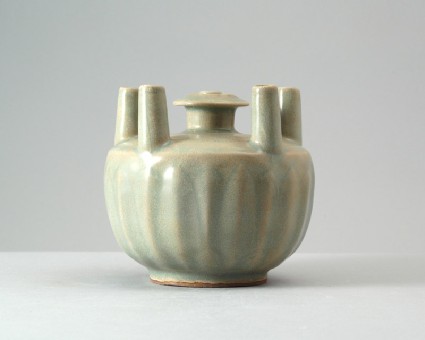The Barlow Collection
A select catalogue of the Barlow collection of Chinese Ceramics, Bronzes and Jades by the University of Sussex (published Sussex, 2006).

Publications online: 456 objects
Greenwar funerary jar with five spouts
- loan
-
Literature notes
Vessels of this type, whose tubular spouts open into the body – unlike the sockets of funerary jars such as [LI1301.211] and [LI1301.308] – have been identified as lamps by Zho Boqian, the senior archaeologist of the Longquan region. Several such lamps have been recovered from a hoard in Suining county, Sichuan province, believed to have been buried around the time the Mongols invaded the area, in 1234, and before the town fell, in 1242.
The vessel has a wide body with nearly straight sides, curving in towards the straight, unevenly shaped foot, and an angled slanting shoulder applied with five tubular spouts, evenly spaced around a short narrow neck with broad slanting rim. The light blue-green glaze fully covers the piece except for the footring, which has fired a buff tone. It is suffused with paler specks due to burial degradation. -
Details
- Associated place
-
Asia › China › Zhejiang province › Longquan kilns (place of creation)
- Date
-
13th century (1201 - 1300)
Southern Song Dynasty (1127 - 1279)
- Material and technique
- stoneware, thrown, with carved decoration under a green celadon glaze; spouts hand-modelled and luted to the jar with slip; glazed base; glazed rim
- Dimensions
-
12.4 cm (height)
12.6 cm (diameter)
at foot 7.7 cm (diameter)
- Material index
- Technique index
- Object type index
-
container › vessel › pot › burial-pot,
- No. of items
- 1
- Credit line
- Lent by the Sir Alan Barlow Collection Trust.
- Accession no.
- LI1301.272
-
Further reading
University of Sussex, and Arts and Humanities Research Council, The Barlow Collection, supervised by Regina Krahl, Maurice Howard, and Aiden Leeves (Sussex: University of Sussex, 2006), no. C267
Glossary (4)
glaze, luted, slip, stoneware
-
glaze
Vitreous coating applied to the surface of a ceramic to make it impermeable or for decorative effect.
-
luted
The fusion of parts of ceramics using dilute clay slip.
-
slip
A semi-fluid clay applied to a ceramic before glazing either to coat the surface or for decorative effect.
-
stoneware
Ceramic material made of clay which is fired to a temperature of c.1200-1300⁰c and is often buff or grey in colour.
Location
-
- currently in research collection
Objects are sometimes moved to a different location. Our object location data is usually updated on a monthly basis. Contact the Jameel Study Centre if you are planning to visit the museum to see a particular object on display, or would like to arrange an appointment to see an object in our reserve collections.
Publications online
-

The Barlow Collection
Vessels of this type, whose tubular spouts open into the body – unlike the sockets of funerary jars such as [LI1301.211] and [LI1301.308] – have been identified as lamps by Zho Boqian, the senior archaeologist of the Longquan region. Several such lamps have been recovered from a hoard in Suining county, Sichuan province, believed to have been buried around the time the Mongols invaded the area, in 1234, and before the town fell, in 1242.
The vessel has a wide body with nearly straight sides, curving in towards the straight, unevenly shaped foot, and an angled slanting shoulder applied with five tubular spouts, evenly spaced around a short narrow neck with broad slanting rim. The light blue-green glaze fully covers the piece except for the footring, which has fired a buff tone. It is suffused with paler specks due to burial degradation.
Notice
Object information may not accurately reflect the actual contents of the original publication, since our online objects contain current information held in our collections database. Click on 'buy this publication' to purchase printed versions of our online publications, where available, or contact the Jameel Study Centre to arrange access to books on our collections that are now out of print.
© 2013 University of Oxford - Ashmolean Museum




